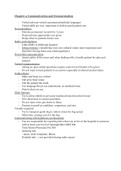Class notes
Lecture notes Clinical Chemistry III (HCC301) Clinical Chemistry: Principles, Techniques, and Correlations
- Institution
- Nelson Mandela Metropolitan University (NMMU)
This document is a compilation of my lecturer's notes and information straight from the textbook with all the figures, tables and all the necessary content to excel in your exam.
[Show more]












